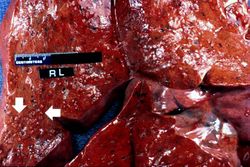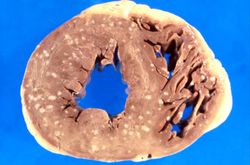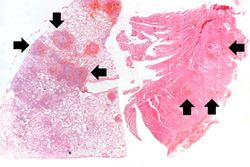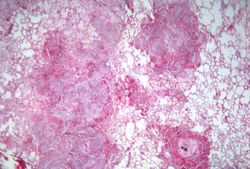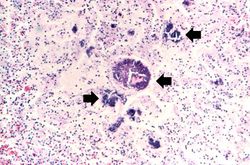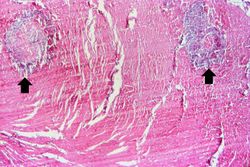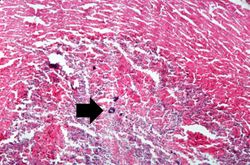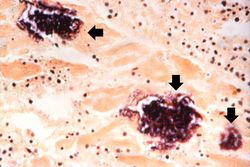Difference between revisions of "IPLab:Lab 4:Septic Emboli"
Seung Park (talk | contribs) |
(→Clinical Summary) |
||
| (4 intermediate revisions by 2 users not shown) | |||
| Line 1: | Line 1: | ||
== Clinical Summary == | == Clinical Summary == | ||
| − | This 4-year-old female sustained second and third degree burns involving approximately forty percent of the body surface. Subsequently, she developed septicemia secondary to skin infection and died in septic shock on the 10th hospital day. Antemortem blood cultures were positive for Enterobacter aerogenes and Staphylococcus aureus. | + | This 4-year-old female sustained second and third degree burns involving approximately forty percent of the body surface. Subsequently, she developed septicemia secondary to skin infection and died in septic shock on the 10th hospital day. Antemortem blood cultures were positive for Enterobacter aerogenes and Staphylococcus aureus. |
| − | + | Postmortem findings included (1) multiple abscesses diffusely distributed throughout the parenchyma of the lung and heart, (2) lobular pneumonia, and (3) visceral congestion. | |
| − | |||
| − | Postmortem findings included (1) multiple abscesses diffusely distributed throughout the parenchyma of the lung and heart, (2) lobular pneumonia, and (3) visceral congestion. | ||
== Images == | == Images == | ||
| Line 18: | Line 16: | ||
File:IPLab4SepticEmboli8.jpg|This is a high-powered photomicrograph of a myocardial abscess stained with a special tissue Gram stain (Brown & Brenn) to illustrate the colonies of bacteria in this myocardial tissue (arrows). | File:IPLab4SepticEmboli8.jpg|This is a high-powered photomicrograph of a myocardial abscess stained with a special tissue Gram stain (Brown & Brenn) to illustrate the colonies of bacteria in this myocardial tissue (arrows). | ||
</gallery> | </gallery> | ||
| + | |||
| + | == Virtual Microscopy == | ||
| + | <peir-vm>IPLab4SepticEmboli</peir-vm> | ||
== Study Questions == | == Study Questions == | ||
* <spoiler text="What is the most common cause of septicemia in burn patients?">Pseudomona aeruginosa.</spoiler> | * <spoiler text="What is the most common cause of septicemia in burn patients?">Pseudomona aeruginosa.</spoiler> | ||
* <spoiler text="What factors dictate the location of the abscesses formed by septic emboli?">Distribution of blood flow downstream from the source of septic emboli.</spoiler> | * <spoiler text="What factors dictate the location of the abscesses formed by septic emboli?">Distribution of blood flow downstream from the source of septic emboli.</spoiler> | ||
| + | |||
| + | == Additional Resources == | ||
| + | === Reference === | ||
| + | * [http://emedicine.medscape.com/article/168402-overview eMedicine Medical Library: Septic Shock] | ||
| + | * [http://emedicine.medscape.com/article/234587-overview eMedicine Medical Library: Bacterial Sepsis] | ||
| + | * [http://emedicine.medscape.com/article/169640-overview eMedicine Medical Library: Multisystem Organ Failure of Sepsis] | ||
| + | * [http://www.merckmanuals.com/professional/critical_care_medicine/sepsis_and_septic_shock/sepsis_and_septic_shock.html Merck Manual: Sepsis and Septic Shock] | ||
| + | * [http://www.merckmanuals.com/professional/infectious_diseases/biology_of_infectious_disease/bacteremia.html Merck Manual: Bacteremia] | ||
| + | |||
| + | === Journal Articles === | ||
| + | * Hiorns MP, Screaton NJ, Müller NL. [http://www.ncbi.nlm.nih.gov/pubmed/11699665 Acute lung disease in the immunocompromised host]. ''Radiol Clin North Am'' 2001 Nov;39(6):1137-51, vi. | ||
| + | |||
| + | === Images === | ||
| + | * [{{SERVER}}/library/index.php?/tags/732-vasculitis_due_to_septic_embolus PEIR Digital Library: Vasculitis Due to Septic Embolus Images] | ||
| + | * [http://library.med.utah.edu/WebPath/LUNGHTML/LUNGIDX.html#7 WebPath: Pulmonary Thromboembolus] | ||
| + | * [http://library.med.utah.edu/WebPath/ATHHTML/ATHIDX.html WebPath: Atherosclerosis and Thrombosis] | ||
| + | |||
| + | == Related IPLab Cases == | ||
| + | * [[IPLab:Lab 3:Lobar Pneumonia|Lab 3: Lung: Lobar Pneumonia]] | ||
| + | * [[IPLab:Lab 4:Thromboembolus|Lab 4: Lung: Thromboembolus]] | ||
{{IPLab 4}} | {{IPLab 4}} | ||
[[Category: IPLab:Lab 4]] | [[Category: IPLab:Lab 4]] | ||
Latest revision as of 02:00, 24 June 2020
Contents
Clinical Summary[edit]
This 4-year-old female sustained second and third degree burns involving approximately forty percent of the body surface. Subsequently, she developed septicemia secondary to skin infection and died in septic shock on the 10th hospital day. Antemortem blood cultures were positive for Enterobacter aerogenes and Staphylococcus aureus.
Postmortem findings included (1) multiple abscesses diffusely distributed throughout the parenchyma of the lung and heart, (2) lobular pneumonia, and (3) visceral congestion.
Images[edit]
Virtual Microscopy[edit]
Study Questions[edit]
Additional Resources[edit]
Reference[edit]
- eMedicine Medical Library: Septic Shock
- eMedicine Medical Library: Bacterial Sepsis
- eMedicine Medical Library: Multisystem Organ Failure of Sepsis
- Merck Manual: Sepsis and Septic Shock
- Merck Manual: Bacteremia
Journal Articles[edit]
- Hiorns MP, Screaton NJ, Müller NL. Acute lung disease in the immunocompromised host. Radiol Clin North Am 2001 Nov;39(6):1137-51, vi.
Images[edit]
- PEIR Digital Library: Vasculitis Due to Septic Embolus Images
- WebPath: Pulmonary Thromboembolus
- WebPath: Atherosclerosis and Thrombosis
Related IPLab Cases[edit]
| |||||
Sepsis is the presence and persistence of pathogenic microorganisms and their toxins in the blood.
An abscess is a collection of pus (white blood cells) within a cavity formed by disintegrated tissue.
In alcoholics, aspiration pneumonia is common--bacteria enter the lung via aspiration of gastric contents.
Plural of embolus. An embolus is something that blocks the blood flow in a blood vessel. It may be a gas bubble, a blood clot, a fat globule, a mass of bacteria, or other foreign body. It usually forms somewhere else and travels through the circulatory system until it gets stuck.
An abscess is a collection of pus (white blood cells) within a cavity formed by disintegrated tissue.
